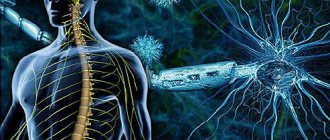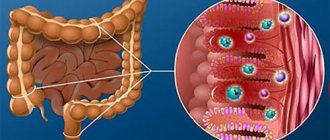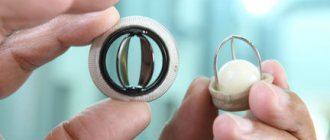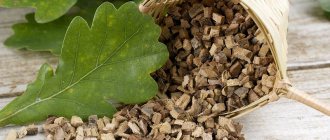Causes of volvulus
Pathology manifests itself at different ages; the development factor may be:
- An inflammatory process with the formation of adhesions, which is the result of diseases of the pelvic organs, operations in the abdominal cavity, and mechanical blunt trauma to the abdomen.
- Compression of a section of the digestive tract by nearby organs and tumors.
- The introduction of a certain part of the intestine into the lumen of another intestine, a revolution around an axis, the formation of an intestinal loop, wrapping around the mesentery, a special abdominal fold that secures organs in an anatomically correct position.
- The existence of congenital anomalies of the intestinal tract.
- Spasms of the walls of the tract, paralysis of its individual sections.
- A large amount of coarse fiber food, which greatly enhances peristalsis and intestinal volume.
- Worm infestation.
- Mechanical blockage of the intestinal lumen by a foreign body.
Possible complications
If you do not see a doctor on time, this can lead to dangerous complications. Within a few hours after the incident, peritonitis will begin to develop.
The body temperature becomes higher, and a false improvement in general condition will temporarily occur. But in the absence of certain medical care, the patient will face a number of complications and death.
List of possible complications:
- necrosis of the digestive tube;
- suppuration;
- intra-abdominal infection;
- general intoxication of the body;
- secondary intestinal torsion;
- dehydration;
- wall perforation.
As a result of such complications, as a rule, additional secondary disturbances appear in the functioning of all vital human organs, including the heart.
The main danger is that the consequences of the pathology develop very quickly. Therefore, if you notice the slightest symptoms, you should immediately go to a medical facility.
How does the disease manifest itself?
In order to promptly seek emergency help, you need to know what symptoms indicate volvulus in adults:
- constipation, lack of stool and waste gases;
- severe pain in the form of attacks, contractions;
- dry mouth, bitterness, unpleasant aftertaste, foul-smelling belching;
- nausea and vomiting with the taste of feces (due to obstruction, part of the processed food is thrown back into the stomach cavity and excreted with the masses during vomiting);
- asymmetrical bloating of the abdomen (usually the swollen abdomen is skewed);
- decreased blood pressure, increased heart rate;
- rise in temperature;
- loss of consciousness;
- deterioration of the condition over time (the further, the worse).
Diagnosis and treatment are carried out in a hospital setting by a gastroenterologist or surgeon. The patient must understand that pathology requires urgent, qualified medical assistance.
Treatment and prognosis
A mandatory component of therapy is surgery, without which intestinal obstruction cannot be eliminated.
Conservative treatment
Conservative treatment is preparation for surgery. It includes:
- Insertion of a nasogastric tube and elimination of stomach contents through it to reduce the load on the intestines.
- Infusion therapy, correction of electrolyte disturbances.
- If there are signs of peritonitis - antibacterial therapy.
- Premedication – preparing the patient for anesthesia.
Surgery
After preparation for the intervention, the patient is given anesthesia and the operation begins. It includes the following steps:
- Opening the abdominal cavity.
- Removal of pathological contents.
- Inspection of the intestine, assessment of its viability.
- Straightening out twisted loops.
- In the presence of necrosis, removal of dead tissue, including the healthy area before and after it, to prevent remission of the disease.
- If peritonitis is detected, an ileostomy is applied, which is a direct connection between the intestinal cavity and the external environment, through which feces will be excreted.
- 3 months after the stoma is applied, reconstructive surgery is performed and anastomoses (connections of intestinal loops) are performed.
Postoperative measures
After surgery, treatment is carried out aimed at preventing complications. It includes:
- Massive antibiotic therapy.
- Infusion therapy.
- Treatment of the surgical wound.
- Constant monitoring of patients.
Volvulus is a dangerous condition that occurs for various reasons and can cause serious complications.
Often we are talking about a fatal outcome. With such disorders, intestinal function is blocked.
How to treat volvulus
If there is no peritonitis, then with timely detection of pathology after a clinical examination, it is possible to use conservative measures:
- painkillers are prescribed;
- give drugs that reduce intoxication;
- do a siphon enema, bowel cleansing procedures using a special probe;
- if the examination results allow, air is introduced to straighten the compressed area, using equipment designed for this.
In case of insufficiency of the above measures or progressive deterioration, prompt measures are applied:
- palliative intervention - the volvulus is eliminated, the intestinal tract is fixed;
- radical - they perform a primary resection of the damaged intestine, which for the most part eliminates the occurrence of recurrences of the pathology;
- a special tube is inserted into the sigmoid colon (if it is damaged).
Diagnostics
When making a diagnosis, the doctor relies on:
- patient survey data;
- objective examination with the establishment of specific symptoms;
- radiography, types of computed tomography, MRI of the abdominal organs;
- Ultrasound and laboratory diagnostic data.
Radiographic signs are manifested by the presence of swollen sections of the intestine with peculiar “cups”, pronounced haustra and a characteristic wide level of fluid (sometimes up to 20 cm). There is a delay in the passage of barium.
Specific X-ray signs of barium examination are observed with volvulus of the sigmoid colon.
The examination allows us to identify 3 stages of the process:
- Turn 180°. The contrast penetrates to the rectosigmoid segment of the intestine, forming a “beak”. By its direction you can determine the turning direction. If the beak is to the left, the gut is to the right and vice versa.
- 360°. The “penguin” is clearly visible on the monitor or picture.
- More than 360°. Only a smaller portion of the intestine is contrasted.
Changes in the blood:
- pronounced leukocytosis;
- accelerated ESR;
- decrease in the number of red blood cells;
- decreased hemoglobin values.
Disease prevention
In the case of this pathology, traditional medicine is not used as a remedy, but is of a preventive nature. Herbal medicine is aimed at eliminating congestion in the intestinal tract, which can cause volvulus.
- Cleansing the intestinal tract with flax: place a tablespoon of whole flax seeds in a thermos, add half a liter of just boiled water. In the morning, on an empty stomach, drink half of the strained portion of flaxseed jelly, the second part is consumed shortly before bed. It is recommended to use it to cleanse the intestinal tract for a week.
- Pumpkin Pulp: Oven-roasted pumpkin is an effective cleanser. Cut the pumpkin pulp into pieces (about three by three centimeters), bake until tender, covered with foil, do not use the baked crusts. They eat the pulp itself or add honey. The product eliminates spasms of the walls of the digestive system, gently weakens, removes toxins, and enriches the body with vitamins and minerals. It is recommended to include it in the diet on an ongoing basis. Pumpkin porridge is also made from the pulp, which has the same properties.
- Red beets: Eating a salad of boiled beets relieves pain, restoring normal bowel movements. Do not be alarmed if black stool appears; this is possible when taking beets. Kvass made from beets has a good effect (the ingredients are indicated per 3 liters of composition) - to prepare kvass according to Bolotov, peeled beets (1.0 kg) are grated on a coarse grater or crushed with a blender, you can simply cut them into small pieces. The strained whey is heated to a temperature of 35-40°C, a teaspoon of sour cream, 60-70 grams of sugar are added to it, and mixed well. The chopped beets are placed in a three-liter jar and filled with a whey mixture. The neck of the jar is tied with gauze in two or three layers.
During the fermentation process, foam is removed from the composition every day. On the 7-8th day, put the kvass in the refrigerator for a day, taking it out at night, do not forget to remove the foam. After 10-12 days, the kvass is ready. The composition is filtered, sealed, and stored in the refrigerator. Take a tablespoon of kvass in the morning on an empty stomach, and twice more in between meals. The product contains a large amount of minerals, vitamins, and other beneficial substances. Kvass strengthens the immune system, helps relieve constipation, normalizes metabolism in the body, lowers cholesterol levels, removes waste, and reduces the content of toxins.
Contraindications for use: gastritis with increased acidity, stomach ulcers, urolithiasis, cholelithiasis, gout.
- Plum compote and eating fresh plums help restore normal stools.
- A decoction of cumin, dill, and fennel seeds, prepared according to the classic recipe (a tablespoon per quarter liter of boiling water, brew for half an hour in a thermos), helps improve stools and relieve constipation and flatulence.
- Sea buckthorn oil (homemade or pharmacy) is used as a mild laxative - a teaspoon before meals (about 30 minutes).
Useful tips
A few recommendations for a preventative plan:
- Try to normalize your diet, do not overeat. Particular harm occurs in the case of a diet or fasting, after which one pounces on food without using a smooth exit from the diet.
- It is necessary to monitor the regularity of bowel movements, avoiding constipation.
- Lead an active, healthy lifestyle.
Maybe you will be interested in information about the causes of inflammation of the lymph nodes under the arm? Or why does a dry nose and blood crusts appear? Articles by our authors cover these and many other topics. Tell me, have you ever experienced volvulus? What actions did you take?











